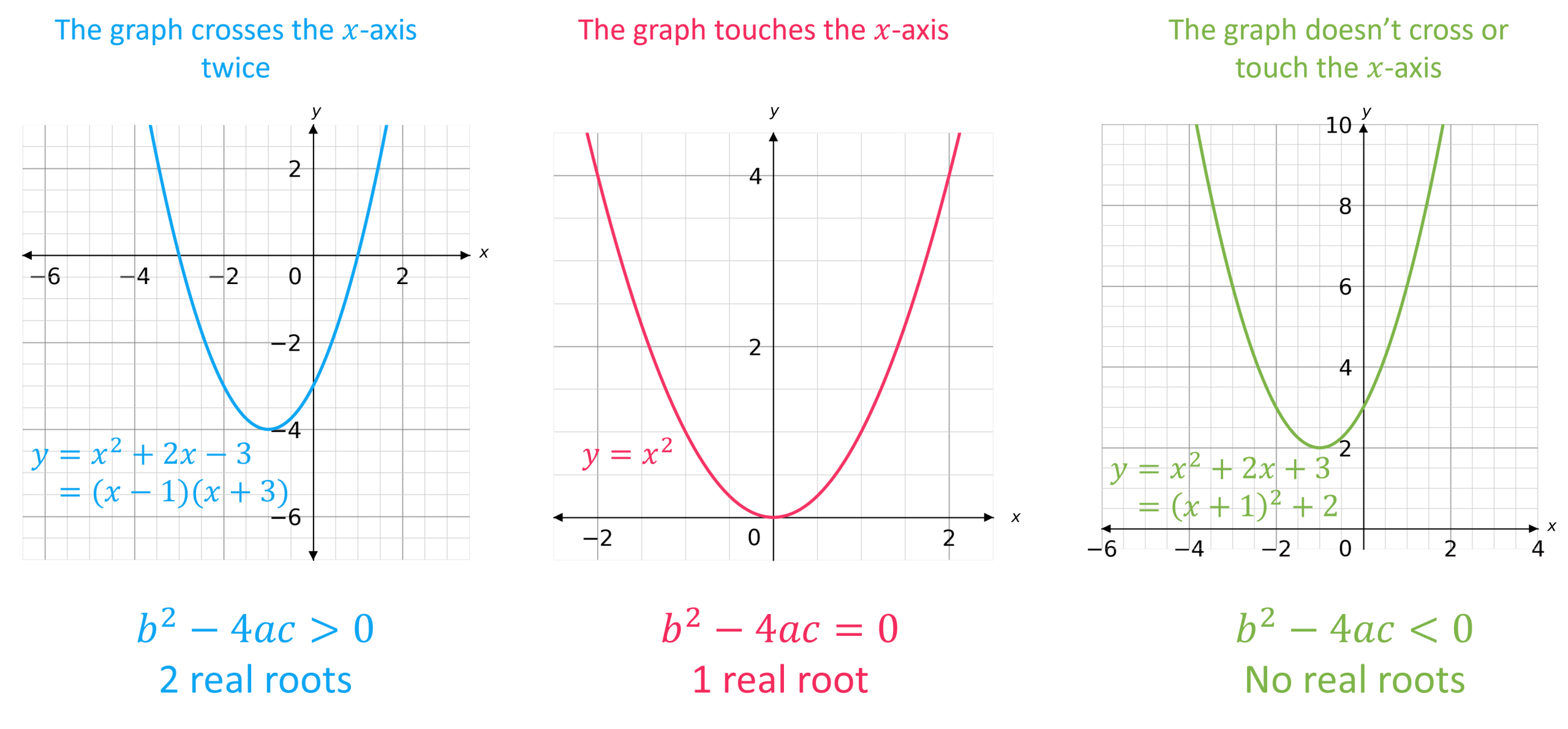The Quadratic Formula
The Quadratic Formula Revision
The Quadratic Formula
The Quadratic Formula is used to find the solutions to any quadratic equation.
The following topics are referred to in this page.
The Quadratic Formula
The solutions to the quadratic equation
\textcolor{red}{a} x^2 + \textcolor{blue}{b}x + \textcolor{limegreen}{c} = 0
are given by the quadratic formula:
x=\dfrac{-\textcolor{blue}{b}\pm\sqrt{\textcolor{blue}{b}^2-4\textcolor{red}{a}\textcolor{limegreen}{c}}}{2\textcolor{red}{a}}
Note: There are two solutions for x: one using + and the other using -
The Discriminant
The discriminant of the quadratic formula (written as D or \Delta) is the part under the square root sign. i.e. the discriminant is
b^2-4ac
It can be positive, zero or negative – these tell us how many roots the quadratic equation has:
- If b^2 - 4ac > 0, then the quadratic has 2 real roots (that are distinct)
- If b^2 - 4ac = 0, then the quadratic has 1 real root (or ‘equal roots’)
- If b^2 - 4ac < 0, then the quadratic has no real roots
This can be seen visually:

Note: We say no ‘real’ roots since some quadratics can have ‘imaginary’ roots – however we will not see this in this course.
Example 1: Using the Quadratic Formula
Find the solutions to the quadratic equation 3x^2 - 8x + 2=0, giving your answers in surd form.
[2 marks]
a = 3, b = -8 and c = 2
Put these values into the quadratic formula:
\begin{aligned} x &= \dfrac{-(-8) \pm \sqrt{(-8)^2 - 4 \times 3 \times 2}}{2 \times 3} \\ &= \dfrac{8 \pm \sqrt{40}}{6} \\ &= \dfrac{4 \pm \sqrt{10}}{3} \end{aligned}
So, x = \textcolor{orange}{\dfrac{4 + \sqrt{10}}{3}} or \textcolor{orange}{x = \dfrac{4 - \sqrt{10}}{3}}
Example 2: Finding the Discriminant
How many real roots does the quadratic equation 2x^2 - 5x + 3=0 have?
[2 marks]
a = 2, b = -5 and c = 3
So, the discriminant is
b^2-4ac = (-5)^2 - 4 \times 2 \times 3 = 1
The discriminant is >0, so 2x^2 - 5x + 3=0 has two real roots.
Example 3: Using the Discriminant
f(x) = 2x^2 + 4x + k. Find the values of k for which f(x)=0 has no real roots.
[3 marks]
a = 2, b = 4 and c = k
The discriminant is
b^2 - 4ac = 4^2 - 4 \times 2 \times k = 16 - 8k
The quadratic equation has no real roots, therefore b^2 - 4ac < 0
So,
\begin{aligned} 16 - 8k &< 0 \\ 16 &< 8k \\ \textcolor{orange}{k} &\textcolor{orange}{> 2} \end{aligned}
Example 4: Using the Discriminant
kx^2 + 2kx + 3 = 0 has two distinct real roots.
Find the set of values for which k satisfies this.
[5 marks]
a = k, b = 2k and c = 3
The discriminant is
b^2 - 4ac = (2k)^2 - (4 \times k \times 3) = 4k^2 - 12k
Since the quadratic equation has two distinct real roots, the discriminant must be >0
4k^2 - 12k > 0
The quadratic can be factorised:
4k^2 - 12k = 4k(k-3)
This is 0 when k=0 or when k=3
Hence, 4k(k-3)>0 when \textcolor{orange}{k<0} or when \textcolor{orange}{k>3}
Note: You can draw a graph of y = 4k(k-3) to help – you would see a u-shaped graph that crosses the k-axis at 0 and 3 (see inequalities).
The Quadratic Formula Example Questions
Question 1: Solve 2x^2 - 4x = 1, giving your answers to 2 decimal places.
[2 marks]
Rearrange the equation so that it is in the form ax^2 + bx + c = 0:
2x^2 - 4x - 1 = 0
Then, a = 2, b = -4 and c = -1
Put these values into the quadratic formula:
\begin{aligned} x &= \dfrac{-(-4) \pm \sqrt{(-4)^2 - 4 \times 2 \times -1}}{2 \times 2} \\ &= \dfrac{4 \pm \sqrt{24}}{4} \\ &= \dfrac{2 \pm \sqrt{6}}{2} \end{aligned}
So,
x = \dfrac{2 + \sqrt{6}}{2} = 2.22 \text{ (2 dp)}
x = \dfrac{2 - \sqrt{6}}{2} = -0.22 \text{ (2 dp)}
Question 2: Find the discriminant of 4x - x^2 - 4 and determine how many roots 4x - x^2 - 4 = 0 has.
[2 marks]
Rearrange the equation so that it is in the form ax^2 + bx + c = 0:
-x^2 + 4x - 4 = 0
So, a = -1, b = 4 and c = -4
Then, find the discriminant:
b^2 - 4ac = 4^2 - 4(-1)(-4) = 0
Hence, 4x - x^2 - 4 = 0 has one real distinct root.
Question 3: f(x) = 4x^2 + x + 2k. Find the values of k for which f(x)=0 has two distinct real roots.
[2 marks]
a = 4, b=1 and c = 2k
Find the discriminant:
b^2 - 4ac = 1^2 - 4 \times 4 \times 2k = 1 - 32k
f(x)=0 has two distinct real roots, therefore b^2-4ac > 0:
\begin{aligned} 1 - 32k &> 0 \\ 1 &> 32k \\ k &< \dfrac{1}{32} \end{aligned}
Question 4: (m+1)x^2 + (m+1)x + 2 = 0 has two distinct real solutions for x, with constant m.
a) Show that m^2 - 6m - 7 > 0
b) Hence, find the range for the possible values for m.
[6 marks]
a) a = (m+1), b =(m+1) and c = 2
Find the discriminant:
\begin{aligned} b^2 - 4ac &= (m+1)^2 - 4 \times (m+1) \times 2 \\ &= (m^2 + 2m + 1) - (8m + 8) \\ &= m^2 -6m - 7 \end{aligned}
The equation has two real distinct solutions, therefore b^2 - 4ac >0:
m^2 -6m - 7 > 0
b) m^2 -6m - 7 = (m-7)(m+1)
This expression is 0 when k = 7 and k = -1
Hence, (m-7)(m+1)>0 when m< -1 or when m>7
You May Also Like...

MME Learning Portal
Online exams, practice questions and revision videos for every GCSE level 9-1 topic! No fees, no trial period, just totally free access to the UK’s best GCSE maths revision platform.






